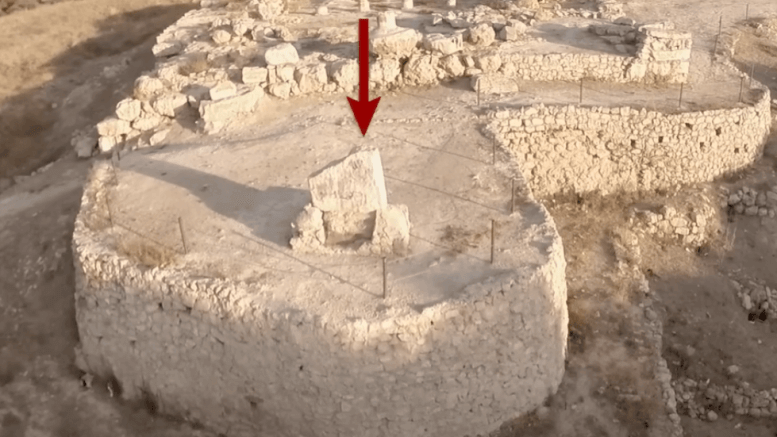Playback speed:
Introduction
In the heart of the Promised Land, nestled between Mount Gerizim and Mount Ebal, lies the ancient city of Shechem—a site rich with biblical history. Here, under the oak near the holy place of the Lord, Joshua erected a large stone to witness Israel’s renewed covenant with God (Joshua 24:26). The significance of this moment cannot be overstated. The recent discovery of what many believe to be this very stone adds a profound layer of authenticity to the biblical narrative. This post explores the discovery of Joshua’s great witness stone, its journey through the ages, and what it means for biblical archaeology today.
The Biblical Context of Shechem
Shechem is paramount in the Bible, serving as a stage for pivotal events in Israel’s history. After entering the Promised Land, Joshua gathered all the tribes of Israel at Shechem, where he renewed the covenant between God and the people. As a symbol of this covenant, Joshua set up a large stone under the oak near the holy place, declaring it a witness against the people should they forsake the Lord (Joshua 24:27).
This stone, therefore, was not just a physical marker but a spiritual witness, carrying the weight of the covenant between God and His people. The significance of this event, as detailed in the Book of Joshua, underscores the stone’s role as a tangible reminder of Israel’s commitment to God.
The Archaeological Discovery
Joel Kramer, a biblical archaeologist featured on the YouTube channel Expedition Bible, brings to light the story of this remarkable discovery. Standing amidst the ruins of ancient Shechem, Kramer shares the incredible journey of how this witness stone was unearthed and nearly lost again through the site’s tumultuous history.
In 1926, German archaeologist Ernst Sellin excavated a massive stone at the site of Shechem, which he initially interpreted as a sacred standing stone or matsebah in Hebrew. Although broken, this stone matched the description and location of the stone mentioned in Joshua 24. As further excavations revealed, this stone was not merely a marker but likely the very witness stone set up by Joshua.
Sellin’s team also discovered the foundations of what was once a grand temple at Shechem, further linking the site to the biblical narrative. The stone, initially believed to be a water trough, was later confirmed to be the base of the sacred stone, solidifying its connection to the biblical account.
Challenges and Triumphs in Archaeology
The journey of this stone did not end with its discovery. The excavation site at Shechem was a battleground of interpretations. Dr. Gabriel Welter, a member of the German excavation team, strongly opposed Sellin’s identification of the stone as the biblical witness stone. In a dramatic turn of events, Welter, upon assuming control of the excavation, toppled the stone from its base and discarded it down a slope, further damaging it.
This act of defiance could have led to the permanent loss of this significant artifact. However, archaeologist G. Ernest Wright recovered the stone in 1960. Wright recognized its importance and painstakingly restored it to its original location. Wright’s work ensured that the stone could once again stand as a testament to the historicity of the biblical account.
The Significance of the Witness Stone
The discovery of Joshua’s witness stone is a profound example of how archaeology can affirm the reliability of Scripture. Without the biblical text, the significance of this stone might have been lost to history. Yet, the rocks come to life when the Bible is brought into the archaeological equation, revealing their true purpose and meaning.
This stone, now standing once more at Shechem, is a broken yet enduring witness to a covenant made thousands of years ago. Its story, from its biblical origins to its near destruction and eventual restoration, mirrors the journey of the covenant itself—a powerful reminder of humanity’s tendency to stray from God and the enduring call to return to Him.
Conclusion
The discovery of Joshua’s great witness stone at Shechem is more than just an archaeological find; it is a tangible connection to the events of the Bible, offering evidence of the historical accuracy and divine inspiration of Scripture. As Joel Kramer eloquently presents in his video on “Expedition Bible,” this stone stands as a testament to the enduring truth of God’s Word, a reminder that what was written in the Bible was not merely myth but recorded history, verified by the very stones unearthed in the Promised Land.
For those interested in exploring the intersection of archaeology and biblical truth, the “Expedition Bible” channel, recommended by the Virginia Christian Alliance, offers an invaluable resource. Through the lens of archaeology, we are invited to delve deeper into the Bible, gaining a richer understanding of its historicity, authenticity, and authority.
References
- Biblical Archaeology: Virginia Christian Alliance
- Biblical Archaeology Society – Explore detailed discussions on ancient Shechem and its biblical significance here.
- Expedition Bible: YouTube Channel and website

